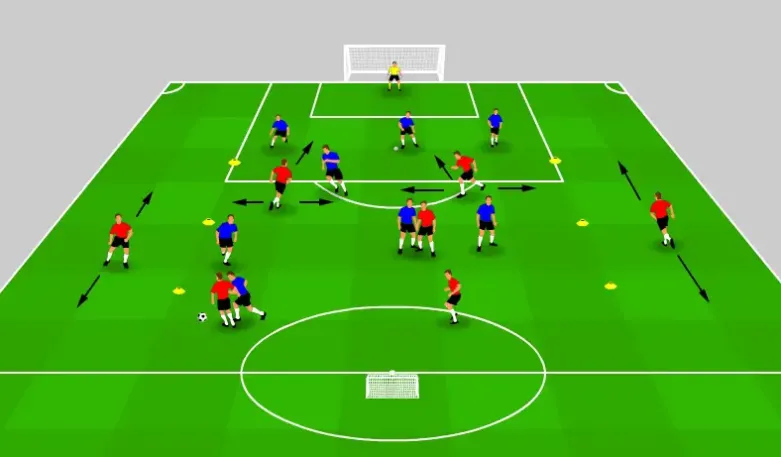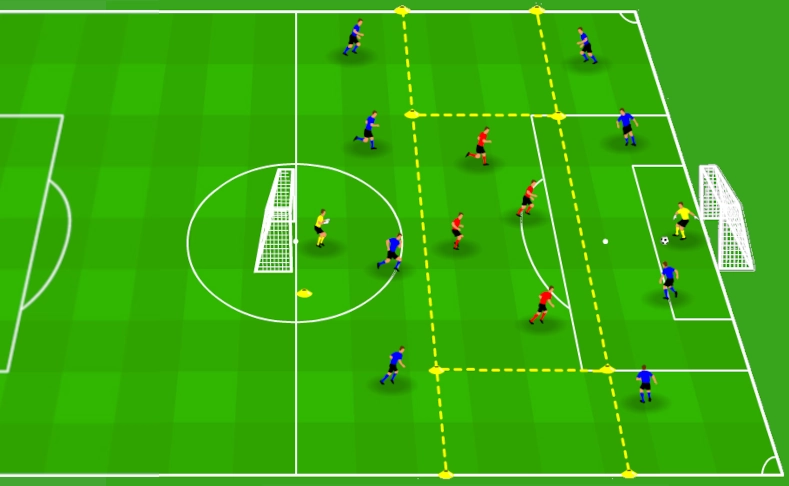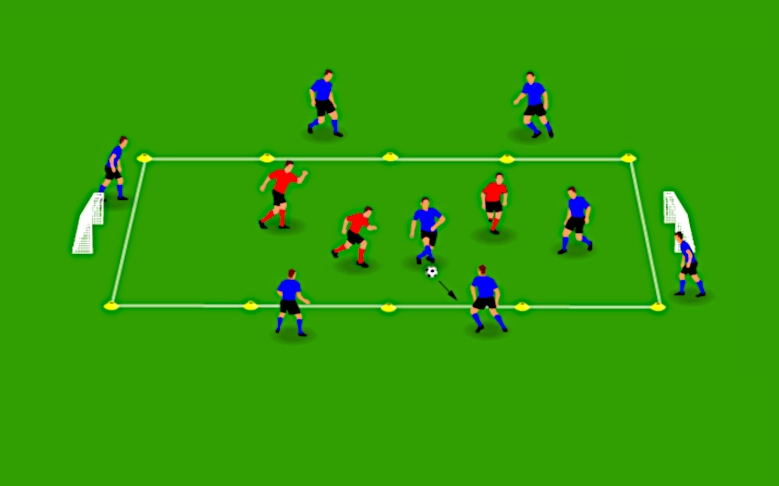Defence vs attack drill with wingers

This is a defence vs attack drill with zones and one full-size goal. The main objective is to practice distribution in the middle of the park and move into the attack with wingers without losing shape.
Setup
This drill requires one half of a football pitch, 1 small goal, and 6 cones to mark the zones, as shown in the picture above. It is designed to involve both your starting players and subs; you will need more than 11 players. We usually practise the drill with 15 players (7 vs. 8) and one goalkeeper.
In the picture, blue players are defending, and red are attacking. Blue players can’t move out of their zones. Red wingers can move freely on the wings. Red strikers can move only in the last two zones of the pitch. Only red strikers can shoot to the big goal. We usually play 3-5-2 (or 3-1-3-1-2), so the blue players are in zones in a 3-1-3-1 formation. Aside from the 2 red wingers, blue players are using a 2-1-2 formation.
The small goal in the midfield motivates the defending team to move from defence to attack in an orderly fashion instead of simply kicking the ball out of danger. Because the defensive team can also score, it forces the attacking team to pressure the defensive players to recover the ball.
Rules
This is a simple football game. The game’s main objective is to keep the shape in the midfield by forcing players to move in a limited zone. Only wingers and strikers have more freedom of movement. In addition to the usual football rules, follow these basic rules:
- 2 teams. In the example, 8 defending players and 7 attacking players.
- Defensive players can only move in their zones.
- Only the two red strikers can move in the last two zones.
- Wingers can move up and down in the wings.
- Only the two strikers can shoot to goal. Even if wingers have a chance to score, they need to find a path to the strikers. They can connect with strikers via a pass on the ground, crossing the ball, or combining with a midfielder who then passes to a striker.
- Only 3 touches are allowed (e.g., 1 touch to control the ball, 1 touch to change direction and 1 touch to pass the ball)
Takeaways
The main objectives of this exercise are to keep the team shape both in attack and defence. In defence, the team must be well organised to score a small goal. There are many skills that this game covers:
- Passing. Because of the limitations imposed by the zones and the number of touches, the only way to move around the park is by bypassing the ball. Players are forced to improve their passing technique.
- Finishing. The game is played with a full-size goal. Your main strikers (they must play in the red team) are faced with real scenarios and encouraged to improve their finishing.
- Teamwork. Because each player has limited touches and a limited area to move, teamwork is encouraged over individual efforts.
- Transitioning from defence into attack. Constantly kicking the ball away to defend will make it harder for the defending team to score in the small goal. Therefore, the team must move from defence to attack in an orderly manner.
- Players positioning. To keep possession of the ball, players must move in a block and stay close to each other. The zones also ensure that players move in a restricted area instead of all over the field without any organisation.
We’d love to hear how this drill benefits your team. Please share your experiences and modifications on our Facebook page or tag us in your training videos.



